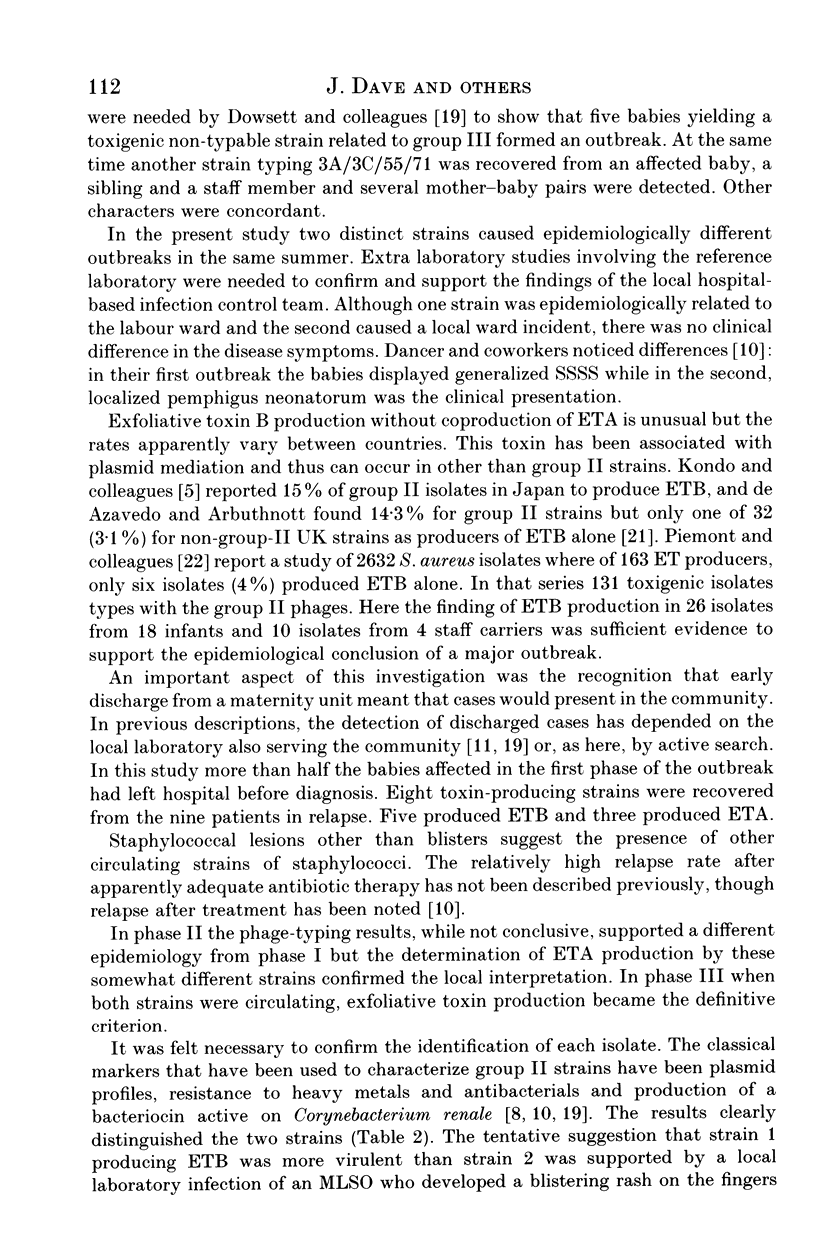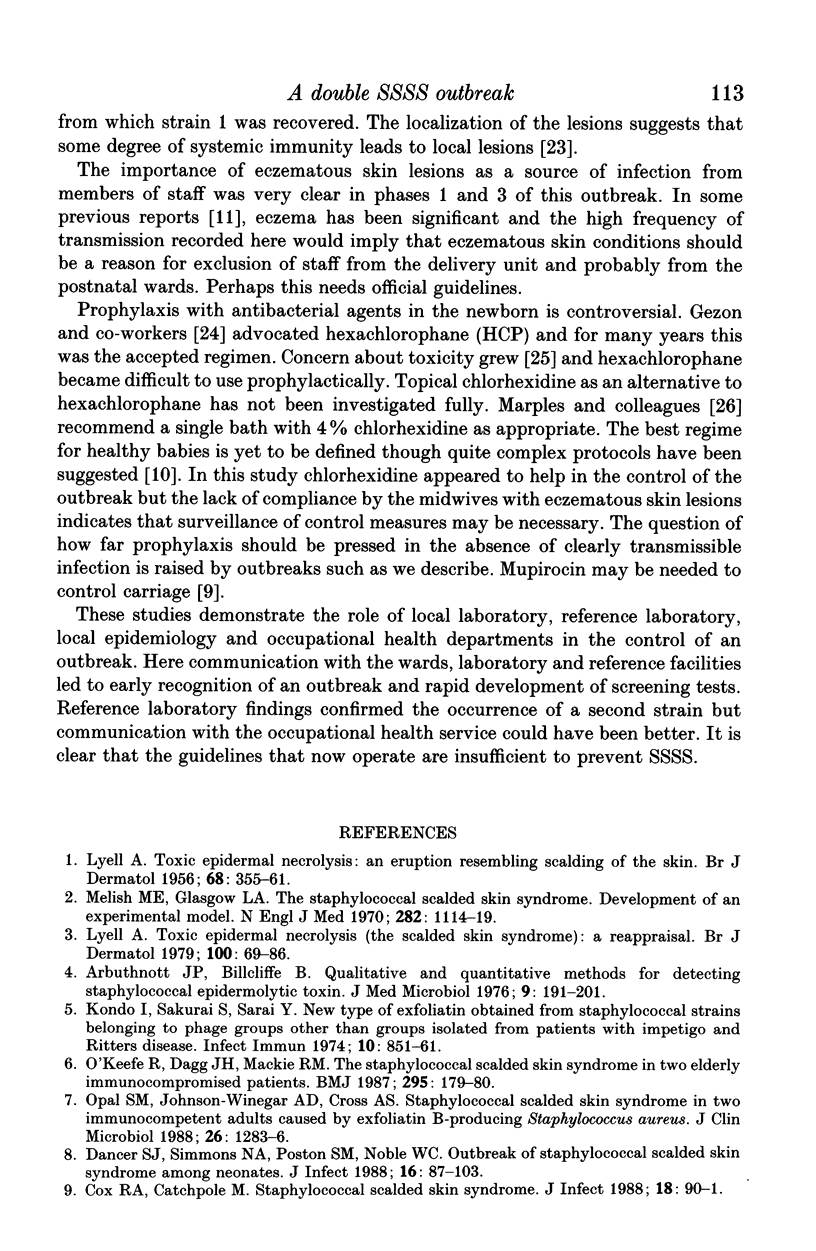Abstract
This report describes a double outbreak of staphylococcal scalded skin syndrome (SSSS) in which two distinct tetracycline-resistant strains of Staphylococcus aureus producing different exfoliative toxins were involved. In the first phase the daytime staff of the delivery unit and eczematous skin conditions in midwives were implicated as the probable source. In the second phase a source within a post-natal ward was suggested with local cross-infection. In the final phase both sources were epidemiologically linked to cases of SSSS. Because early discharge was the policy of the unit many cases presented in the community rather than in the hospital. Confirmation of epidemiological findings was provided by additional laboratory studies. Two distinct strains of S. aureus could be defined, differing in phage-typing patterns, the exfoliative toxin produced, plasmid profile, cadmium resistance and bacteriocin production. Strict care in hand washing with a chlorhexidine-containing detergent was an important control measure.
Full text
PDF











Selected References
These references are in PubMed. This may not be the complete list of references from this article.
- Arbuthnott J. P., Billcliffe B. Qualitative and quantitative methods for detecting staphylococcal epidermolytic toxin. J Med Microbiol. 1976 May;9(2):191–201. doi: 10.1099/00222615-9-2-191. [DOI] [PubMed] [Google Scholar]
- Cox R. A., Catchpole M. Staphylococcal scalded skin syndrome. J Infect. 1989 Jan;18(1):90–91. [PubMed] [Google Scholar]
- Dancer S. J., Poston S. M., East J., Simmons N. A., Noble W. C. An outbreak of pemphigus neonatorum. J Infect. 1990 Jan;20(1):73–82. doi: 10.1016/s0163-4453(90)92434-m. [DOI] [PubMed] [Google Scholar]
- Dancer S. J., Simmons N. A., Poston S. M., Noble W. C. Outbreak of staphylococcal scalded skin syndrome among neonates. J Infect. 1988 Jan;16(1):87–103. doi: 10.1016/s0163-4453(88)96249-4. [DOI] [PubMed] [Google Scholar]
- Degener J. E., Naidoo J. L., Noble W. C., Phillips I., Marples R. R. Carriage of gentamicin-resistant coagulase-negative staphylococci in patients on continuous ambulatory peritoneal dialysis. J Antimicrob Chemother. 1987 Apr;19(4):505–512. doi: 10.1093/jac/19.4.505. [DOI] [PubMed] [Google Scholar]
- Dowsett E. G., Petts D. N., Baker S. L., DeSaxe M. J., Coe A. E., Naidoo J., Noble W. C. Analysis of an outbreak of staphylococcal scalded skin syndrome: strategies for typing 'non-typable' strains. J Hosp Infect. 1984 Dec;5(4):391–397. doi: 10.1016/0195-6701(84)90007-0. [DOI] [PubMed] [Google Scholar]
- GEZON H. M., THOMPSON D. J., ROGERS K. D., HATCH T. F., TAYLOR P. M. HEXACHLOROPHENE BATHING IN EARLY INFANCY. EFFECT ON STAPHYLOCOCCAL DISEASE AND INFECTION. N Engl J Med. 1964 Feb 20;270:379–386. doi: 10.1056/NEJM196402202700801. [DOI] [PubMed] [Google Scholar]
- Hoeger P. H., Elsner P. Staphylococcal scalded skin syndrome: transmission of exfoliatin-producing Staphylococcus aureus by an asymptomatic carrier. Pediatr Infect Dis J. 1988 May;7(5):340–342. [PubMed] [Google Scholar]
- Kerr S., Kerr G. E., Mackintosh C. A., Marples R. R. A survey of methicillin-resistant Staphylococcus aureus affecting patients in England and Wales. J Hosp Infect. 1990 Jul;16(1):35–48. doi: 10.1016/0195-6701(90)90047-r. [DOI] [PubMed] [Google Scholar]
- Kondo I., Sakurai S., Sarai Y. New type of exfoliatin obtained from staphylococcal strains, belonging to phage groups other than group II, isolated from patients with impetigo and Ritter's disease. Infect Immun. 1974 Oct;10(4):851–861. doi: 10.1128/iai.10.4.851-861.1974. [DOI] [PMC free article] [PubMed] [Google Scholar]
- LYELL A. Toxic epidermal necrolysis: an eruption resembling scalding of the skin. Br J Dermatol. 1956 Nov;68(11):355–361. doi: 10.1111/j.1365-2133.1956.tb12766.x. [DOI] [PubMed] [Google Scholar]
- Lyell A. Toxic epidermal necrolysis (the scalded skin syndrome): a reappraisal. Br J Dermatol. 1979 Jan;100(1):69–86. doi: 10.1111/j.1365-2133.1979.tb03571.x. [DOI] [PubMed] [Google Scholar]
- Macrina F. L., Kopecko D. J., Jones K. R., Ayers D. J., McCowen S. M. A multiple plasmid-containing Escherichia coli strain: convenient source of size reference plasmid molecules. Plasmid. 1978 Jun;1(3):417–420. doi: 10.1016/0147-619x(78)90056-2. [DOI] [PubMed] [Google Scholar]
- Marples R. R., Richardson J. F., Newton F. E. Staphylococci as part of the normal flora of human skin. Soc Appl Bacteriol Symp Ser. 1990;19:93S–99S. doi: 10.1111/j.1365-2672.1990.tb01801.x. [DOI] [PubMed] [Google Scholar]
- Melish M. E., Glasgow L. A. The staphylococcal scalded-skin syndrome. N Engl J Med. 1970 May 14;282(20):1114–1119. doi: 10.1056/NEJM197005142822002. [DOI] [PubMed] [Google Scholar]
- O'Keefe R., Dagg J. H., MacKie R. M. The staphylococcal scalded skin syndrome in two elderly immunocompromised patients. Br Med J (Clin Res Ed) 1987 Jul 18;295(6591):179–180. doi: 10.1136/bmj.295.6591.179. [DOI] [PMC free article] [PubMed] [Google Scholar]
- Opal S. M., Johnson-Winegar A. D., Cross A. S. Staphylococcal scalded skin syndrome in two immunocompetent adults caused by exfoliatin B-producing Staphylococcus aureus. J Clin Microbiol. 1988 Jul;26(7):1283–1286. doi: 10.1128/jcm.26.7.1283-1286.1988. [DOI] [PMC free article] [PubMed] [Google Scholar]
- Piemont Y., Rasoamananjara D., Fouace J. M., Bruce T. Epidemiological investigation of exfoliative toxin-producing Staphylococcus aureus strains in hospitalized patients. J Clin Microbiol. 1984 Mar;19(3):417–420. doi: 10.1128/jcm.19.3.417-420.1984. [DOI] [PMC free article] [PubMed] [Google Scholar]
- Richardson J. F., Quoraishi A. H., Francis B. J., Marples R. R. Beta-lactamase-negative, methicillin-resistant Staphylococcus aureus in a newborn nursery: report of an outbreak and laboratory investigations. J Hosp Infect. 1990 Aug;16(2):109–121. doi: 10.1016/0195-6701(90)90055-s. [DOI] [PubMed] [Google Scholar]
- Simkovicová M., Gilbert R. J. Serological detection of enterotoxin from food-poisoning strains of Staphylococcus aureus. J Med Microbiol. 1971 Feb;4(1):19–30. doi: 10.1099/00222615-4-1-19. [DOI] [PubMed] [Google Scholar]
- Threlfall E. J., Rowe B., Ferguson J. L., Ward L. R. Characterization of plasmids conferring resistance to gentamicin and apramycin in strains of Salmonella typhimurium phage type 204c isolated in Britain. J Hyg (Lond) 1986 Dec;97(3):419–426. doi: 10.1017/s0022172400063609. [DOI] [PMC free article] [PubMed] [Google Scholar]
- de Azavedo J., Arbuthnott J. P. Prevalence of epidermolytic toxin in clinical isolates of Staphylococcus aureus. J Med Microbiol. 1981 Aug;14(3):341–344. doi: 10.1099/00222615-14-3-341. [DOI] [PubMed] [Google Scholar]


